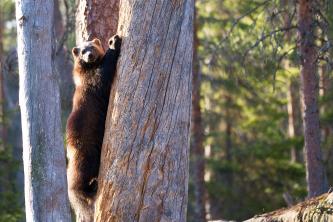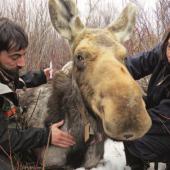Brown & White & Tough All Over
Wolverines of southwest Montana.
The mountains of southwest Montana are a special place for the charismatic carnivores of the American West. Wolves, grizzly bears, black bears, and mountain lions all haunt this high country, with few other places in the nation matching this wealth of wildlife. But even beyond these well-known animals exists another unique species, one that reveals just how wild Montana has remained.
Rarely seen, and photographed even less, this denizen of the snowy mountains is powerful enough to drag a deer across the snow, ornery enough to drive a wolf off a kill, and tough enough to stay active during the icy Rocky Mountain winters while some of its neighbors opt to hibernate.
This formidable animal is the wolverine, which lives north (Bridger Range), south (Gallatin Range), east (Crazy Mountains), and west (Madison Range) of Bozeman, although in low numbers. Reddish-brown, with whitish flanks and weighing an average of 30 pounds, wolverines are the largest member of the Mustelid family, which also includes the fisher, marten, mink, weasel, and black-footed ferret.
Wolverines spend most of their time in the high snowy mountains, wandering the cirques and slopes on short legs looking for carrion to eat. Other creatures, including bears, wolves, coyotes, and wildcats also take an interest in carrion, putting the wolverine in competition with some pretty rough characters. But that's when the wolverine's long claws, fangs, strength, and incredible tenacity are put to work.
In fact, wolverines can sometimes be too tenacious for their own good. This past winter, the body of a dead wolverine was found by researchers after it had apparently tried to take a deer carcass from a black bear--an animal ten times its own size! Given this kind of irascible behavior, it comes as no surprise biologists have given the scientific name of Gulo gulo to the species, Latin for "glutton glutton"
But this wolverine toughness doesn't apply when it comes to people. As wolverines stay active during the cold winter, sometimes they find themselves in the unwelcome company of humans. The noisy nearby activities of snowmobiles and backcountry skiers can drive wolverines out of their high-mountain dens, and occasionally cause them to abandon their young.
Besides sensitivity to people near their dens, wolverines also face a more directed threat: trapping. Montana is the only state in the U.S. that continues to allow lethal trapping of wolverines. This activity is particularly troublesome for wolverines right now, as there are believed to be less than 750 left in the entire lower 48 states. The loss of just a couple breeding females to trapping in a mountain range like the Crazies could doom the entire population in that area.
Yet some folks are working to keep wolverines a part of our American wilderness. A coalition of conservation groups has petitioned for the animal to be listed as an endangered species, and an eagerly anticipated court decision later this year will help determine whether the wolverine is awarded these protections. Already these conservation actions have resulted in the creation of a "sensitive" animal classification by the U.S. Forest Service and The Bureau of Land Management, which should win them considerations when these agencies manage winter recreation and other potentially harmful activities.
If these protection measures are created, the wolverine will continue to be another one of the unique species that make our American West a special place to be.













